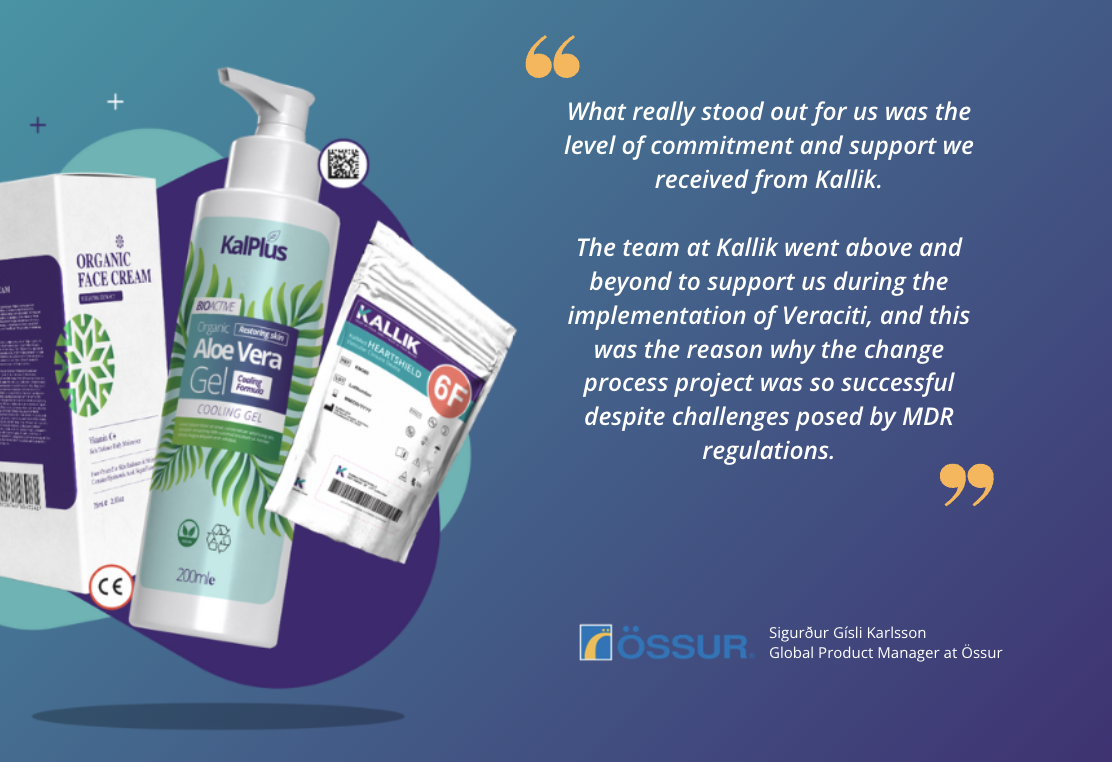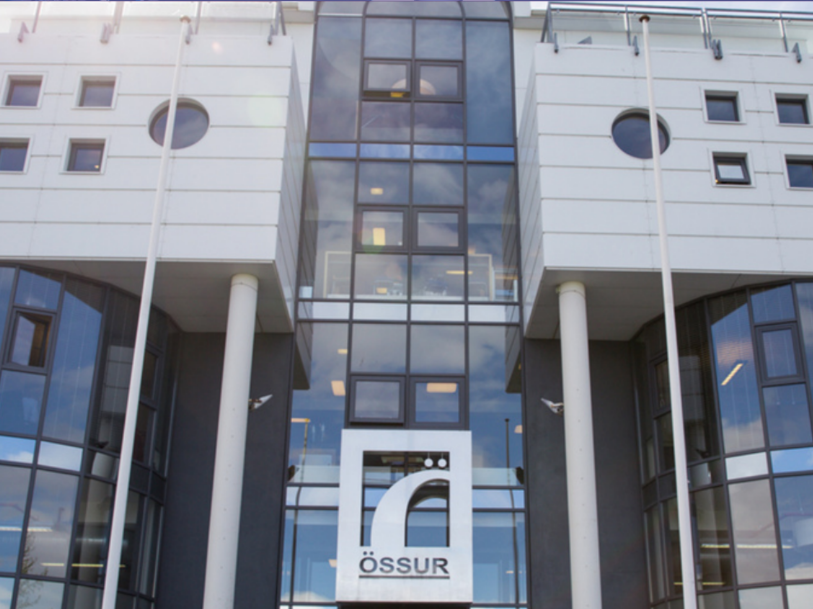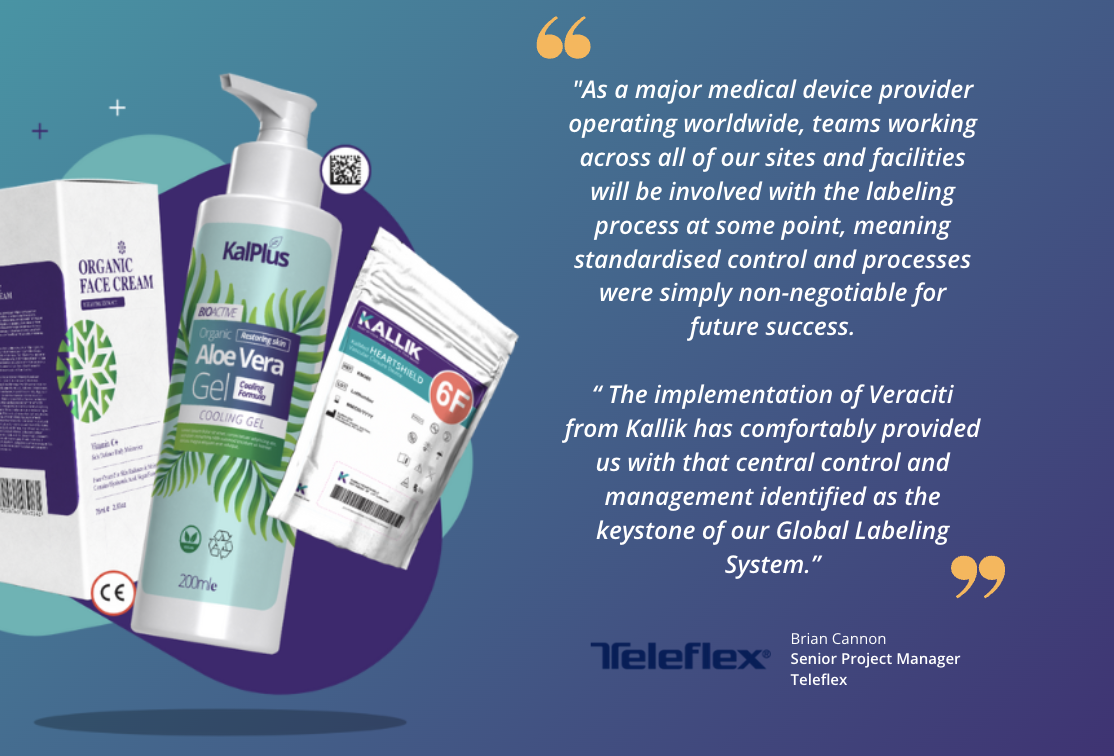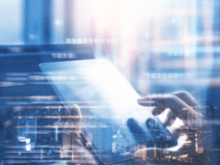Improving Össur’s IFU management and global business operations by overhauling legacy system
With over 50 years of experience in the non-invasive orthopaedics industry, Össur’s mission is to improve people’s mobility.
It is a global leader in non-invasive orthopaedics, developing and manufacturing innovative and life-changing solutions for the prosthetics and bracing & support market. Its operations span more than thirty countries worldwide across the Americas, Europe and Asia, employing over 4,000 staff to improve people’s mobility and quality of life.
Össur had already adopted the Kallik Veraciti™ label and artwork management solution as part of a change process project to drive value and decrease costs. However, new EU MDR regulations meant Veraciti soon became instrumental in the successful completion of MDR compliance across its operations.
Disparate data calls for consolidation into a centralized system
All Össur Class II medical devices require detailed Instructions For Use (IFUs). Due to the critical and often complex nature of these products, Össur’s IFUs contain large blocks of text with longer phrases than typical medical device labels. To add to the complexity, each of Össur’s existing IFUs had been developed by different employees at different times depending on the product release date, and stored in separate documents with a master spreadsheet of all phrases. This dated and manual process was sufficient to create individual IFUs one at a time, but to drive value and lower costs Össur needed to overhaul its legacy systems for more efficient processes.
Challenges
- Disparate, non-standardized legacy systems
- Delays to product launches
- Limited control and management of IFU assets
- Three key operational challenges stemmed from these legacy systems and processes: fragmented data management, a lack of consistency and delayed product launches.
1. Fragmented data management means no visibility
Because each IFU had a separate document for text and artwork, and each unique text asset required individual translation, processing and management, IFU data could only be processed piecemeal in a time-consuming and manual procedure. The resulting disparate IFU documents meant that Össur had very limited visibility across hundreds of global product lines.
2. Lack of consistency in terminology impacts tracking ability
This disparate system for storing IFU data and lack of visibility resulted in many similar products using completely different phrases in their IFUs, with different terminology for the same or similar processes. This not only made it difficult to track and manage product information, as well as translate and update IFUs, but potentially had a negative impact on user experience.
3. Product launch delays
IFUs are the last step in the design process for new products. The inconsistencies and lack of visibility across IFU data assets made IFU approval slow and manual, causing delays to the launch of new products, especially when translations were needed for international markets.
On top of these core operational challenges, pressure from new EU MDR requirements pushed Össur’s IFU management system of disparate documents and mismatched data to the limit. With hundreds of products affected by this regulatory change, thousands of long IFU documents needed updating in a limited amount of time. Össur did not have the visibility into the disparate data sets to fully determine the scale of this compliance task.
Replacing legacy systems with standardization
It is here that the Kallik label and artwork management solution, Veraciti, has helped transform Össur’s business operations. Implementation of Veraciti has allowed Össur to consolidate all IFU phrases into a single centralized system, providing enhanced visibility over all IFU assets. This enabled Össur to identify key phrases that could be reused in multiple product IFUs – even some of the more complex products had a higher rate of phrase reuse than expected. The reusability of key phrases has led to a standardization of IFUs and a streamlining of product information.
This level of control has also enabled Össur to identify the scale of the MDR compliance project and successfully manage the full IFU update process. The ability to pre-approve phrases before they are used ensures every IFU is correct and compliant the first time around, minimizing error and improving efficiency.

Solution
- Veraciti™
- Kallik implementation expertise and technical support
- Smoother operations provide greater value to all stakeholders
Improved visibility and management of IFU phrase assets has significantly enhanced the IFU approval process. The standardization of IFUs through increased reuse of key phrases has reduced IFU cycle times, as IFUs can be designed and built quickly, addressing previous issues with delayed product launches. Increased reusability of phrases has also resulted in decreased costs for translation as less words need to be translated for different product lines.
Veraciti’s centralized database and automation capabilities allow for greater visibility into IFU assets. The increased standardization of IFUs has also made future regulatory compliance easier as Össur now has the powerful systems required to react swiftly and effectively to further regulatory change.
Össur customers also reap the benefits of this business transformation, as product standardization makes IFUs easier to understand and follow, enabling Össur’s customers to complete procedures correctly and efficiently.
Benefits
- Single centralized solution for IFU phrase management
- Simplified IT footprint for ease of management
- Significantly reduced IFU cycle time and translation costs
- Future advancements made possible with Veraciti
Today, Össur is in a strong position to expand Veraciti’s role within the business to label management and potentially along the rest of the value chain, to maintain consistent messaging and brand voice with a centralized data base accessible by all departments.
The advanced automation and cloud capabilities within Veraciti also make the possibility of digital IFUs and labels a reality. Within the platform Össur can create phrases and artwork that are easily integrated into a mobile format. By linking unique phrases with products for mobile use, Össur can provide new value with smart labels.
“For Kallik, software implementation is a partnership – we want to support our clients as much as we can throughout this process,” says Nick Harris, Head of Client Engagement at Kallik. “We are also learning from the experience of customers such as Össur and are always looking for ways to develop our software and continually add new value for our customers.”





